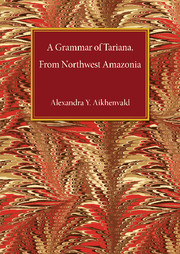Book contents
- Frontmatter
- Dedication
- Contents
- List of tables, schemes and diagrams
- Preface
- Acknowledgements
- Organisation and cross-referencing
- List of abbreviations
- Map
- 1 The language and its speakers
- 2 Phonology
- 3 Word classes
- 4 Nominal morphology and noun structure
- 5 Noun classes and classifiers
- 6 Possession
- 7 Case marking and grammatical relations
- 8 Number
- 9 Further nominal categories
- 10 Derivation and compounding
- 11 Closed word classes
- 12 Verb classes and predicate structure
- 13 Valency changing and argument rearranging mechanisms
- 14 Tense and evidentiality
- 15 Aspect, Aktionsart and degree
- 16 Mood and modality
- 17 Negation
- 18 Serial verb constructions and verb compounding
- 19 Complex predicates
- 20 Participles and nominalisations
- 21 Clause types and other syntactic issues
- 22 Subordinate clauses and clause linking
- 23 Relative clauses
- 24 Complement clauses
- 25 Discourse organisation
- 26 Issues in etymology and semantics
- Appendix. The main features of the Tariana dialects
- Texts
- Vocabulary
- References
- Index of authors, languages and subjects
Organisation and cross-referencing
Published online by Cambridge University Press: 05 August 2013
- Frontmatter
- Dedication
- Contents
- List of tables, schemes and diagrams
- Preface
- Acknowledgements
- Organisation and cross-referencing
- List of abbreviations
- Map
- 1 The language and its speakers
- 2 Phonology
- 3 Word classes
- 4 Nominal morphology and noun structure
- 5 Noun classes and classifiers
- 6 Possession
- 7 Case marking and grammatical relations
- 8 Number
- 9 Further nominal categories
- 10 Derivation and compounding
- 11 Closed word classes
- 12 Verb classes and predicate structure
- 13 Valency changing and argument rearranging mechanisms
- 14 Tense and evidentiality
- 15 Aspect, Aktionsart and degree
- 16 Mood and modality
- 17 Negation
- 18 Serial verb constructions and verb compounding
- 19 Complex predicates
- 20 Participles and nominalisations
- 21 Clause types and other syntactic issues
- 22 Subordinate clauses and clause linking
- 23 Relative clauses
- 24 Complement clauses
- 25 Discourse organisation
- 26 Issues in etymology and semantics
- Appendix. The main features of the Tariana dialects
- Texts
- Vocabulary
- References
- Index of authors, languages and subjects
Summary
A brief overview of the linguistic profile of Tariana is found at the beginning of Chapter 1. Phonology is discussed in Chapter 2. Chapter 3 contains an outline of word classes. Chapters 4–20 deal with various aspects of morphology, while syntactic issues are considered in Chapters 21–24, Chapter 25 deals with discourse organisation, and Chapter 26 provides a brief sketch of semantic issues, especially those relevant to the understanding of the grammar.
Here and passim ‘-’ stands for any morpheme boundary, that is, a boundary between a root and an affix, or between two roots. The symbol ‘=’ indicates a boundary between a root and a clitic, or an affix and a clitic, or two clitics (see Chapter 2). The symbol indicates a primary stress, and x indicates a secondary stress (obligatory on enclitics). Stress is marked on each example in Chapter 2 (‘Phonology’) and in other chapters only if it is relevant to the discussion. Since nasal vowels and long vowels are always stressed, stress on these is not marked.
In Tariana there is a considerable amount of variation between certain allophones (discussed in Chapter 2). Examples of alternative pronunciations are yápi, ñápi ‘bone’, yápu, ñápu ‘stream’, yama, ñama ‘two’, pamúya, pamúña ‘middle’, -pidena, -pidana ‘remote past reported’, -naku, -naku ‘topical non-subject’, -nuka, -naka ‘present visual’, di-keña, di-keñwa ‘he begins’. There is also variation between long vowels and short vowels, e.g. ke:ri, keri ‘moon’, na:, na ‘they went, they said’.
- Type
- Chapter
- Information
- Publisher: Cambridge University PressPrint publication year: 2003



